Archive questioning the history of Turkish dams
ISTANBUL - Hürriyet Daily News

Turkey currently possesses 700 large-scale dams. The new project, which opens an archive of the history of dam constructions, displays 1/50,000-size plexicut models of the big dams on Tigris and Euphrates.
The fifth project of Salt’s “Modern Essays Series” is presenting a critical take of
Turkey’s Westernization efforts during the Republican era through an analysis of its cultivation of river basins through the construction of hydropower plants.
“After the 1930s, Turkey started to rapidly cultivate its river basins to meet its energy demand. As well as being a necessity in the post-industrial world, it was also a reflection of man’s desire to dominate nature,” Aslıhan Demirtaş, an architect on whose work the series is based, told members of the press at the exhibition’s recent opening.
The Modern Essays Series addresses different aspects of Turkey’s modernization process. Demirtaş’s research for Modern Series 5 relies heavily on her PhD dissertation submitted in the 1999-2000 academic year at the Massachusetts Institute of Technology.
A project as a metaphor
The project plays on the metaphor of grafting and draws an analogy between plant cultivation and geographical cultivation. “To implement the shootings of one tree into one branch of another, you need to cut through that branch of the treated plant, which amounts to a heavy intervention into its nature. And although what we have in the end is still a part of nature, our means of getting to it are highly artificial,” Demirtaş said.
“When the first dam was built in Ankara, called the Çubuk Dam, it was presented in media reports as ‘Ankara’s Bosphorus.’ Therefore the project imitates an act of grafting, because they were artificially implementing one particular natural aspect into another natural environment to which the former is remarkably alien.”
Turkey currently possesses 700 large-scale dams. The exhibition displays 1/50,000-size plexicut models of the big dams on Tigris and Euphrates. “This is to concretize, at least partly, the physical aspect of Turkey’s modernization process,” Demirtaş said.
But the exhibition, as well as the research, is also a display of a giant online database accessible through a big touch screen installed on one wall of the exhibition hall. The database tracks the administrative bodies that were authorized to establish hydropower plants throughout the Republican Turkish history.
“After the 1950s, Turkey was divided into 26 regions, each pertaining to one river basin,” Demirtaş said. Different administrative bodies have been authorized in different aspects of dam construction since then, although the active construction of dams was undertaken by the State Waterworks Authority.
The online database, which is in Turkish and English, also allows viewers to track media reports on the construction process of each dam, including reports about environmentalist reactions.
“I gathered all the information I need through publicly open sources. My chief source of reference was a website from the Forest Ministry called ‘geoportal,’” she said. The online database will also be opened for public access at “saltonline.org” in the near future.
The exhibition also includes photographs from the archives of Demirtaş and other collaborators showing ordinary people enjoying the “Bosphorus in Ankara” right after it was built. Modern Essays 5: Graft will continue at Salt Galata until Aug. 26.
